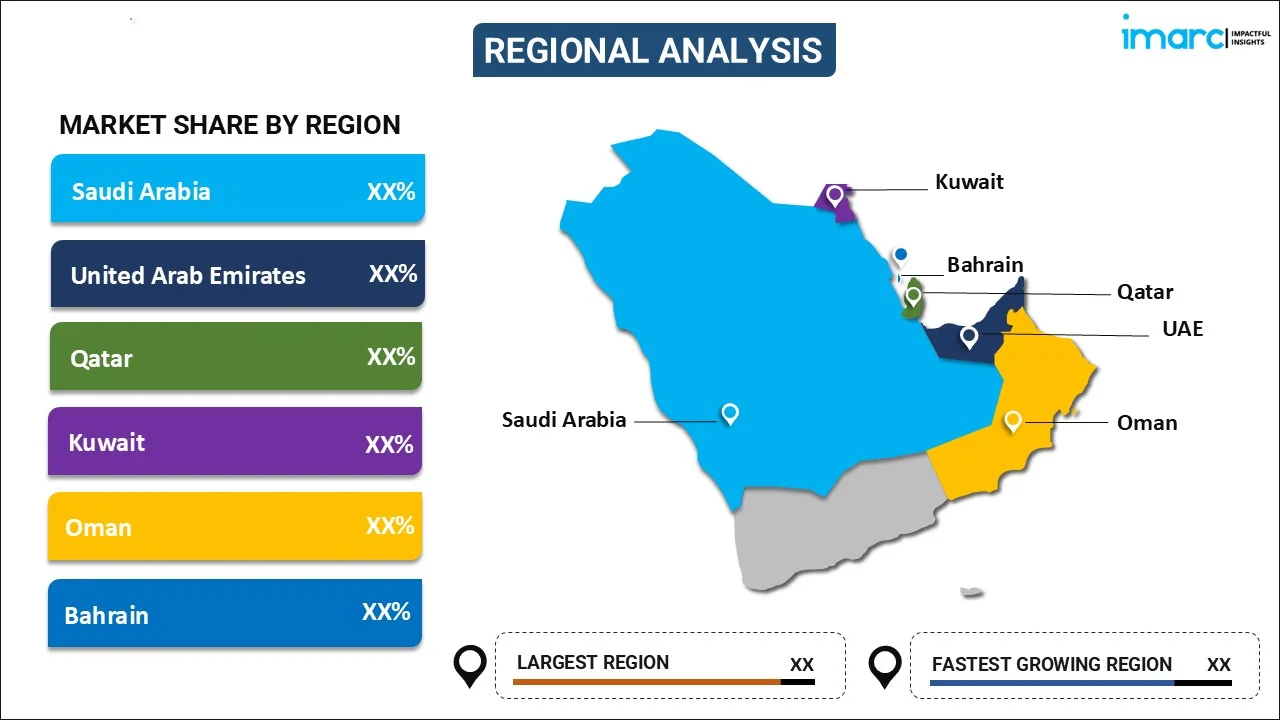
GCC Smart Lighting Market Report by Offering (Hardware, Software, Services), Communication Technology (Wired Technology, Wireless Technology), Installation Type (New Installation, Retrofit Installation), Light Source (LED Lamps, Fluorescent Lamps, Compact Fluorescent Lamps, High Intensity Discharge Lamps, and Others), Application (Commercial, Residential, Public Infrastructure, and Others), and Region 2025-2033
Market Overview:
The GCC smart lighting market size reached USD 573.6 Million in 2024. Looking forward, IMARC Group expects the market to reach USD 2,697.5 Million by 2033, exhibiting a growth rate (CAGR) of 17.83% during 2025-2033.
|
Report Attribute
|
Key Statistics
|
|---|---|
|
Base Year
|
2024
|
|
Forecast Years
|
2025-2033
|
|
Historical Years
|
2019-2024
|
| Market Size in 2024 | USD 573.6 Million |
| Market Forecast in 2033 | USD 2,697.5 Million |
| Market Growth Rate 2025-2033 | 17.83% |
Smart-lighting is a technology designed for efficient use of light resources with power-saving fittings and automated controls. Using smart lighting technology, the consumer is able to adjust the ambient lighting depending upon the occupancy or daylight availability. Smart-lighting products have extensive applications in commercial, industrial and residential sectors and consist of a smartphone-controlled wall keypad and a touchscreen panel. This adds significantly to the convenience of the consumer, as smart lights and bulbs can be programmed to switch on and off at any chosen moment. Various smart bulbs are engineered to produce light that resembles natural sunshine in order to make the consumer feel more productive and fresh, irrespective of night or day. Additionally, it provides a greater sense of security for those who are away from their homes and are able to turn on/off the house lights at their will. Smart lights are also available in multiple colors that add to the aesthetic value of the space and provides the user with a variety in décor and ambiance.
Consistently increasing energy consumption and electricity demands of the GCC region are among the key factors driving the smart lighting market in the region. Moreover, rising economic growth, population growth and increasing government support are also creating a positive impact on the smart lighting market in the region. Consumers are also increasingly adopting smart lighting products due to its cost efficiency and remote accessibility through smartphones and voice-command features. Additionally, increasing investments in smart homes and cities are expanding the market for smart lighting. Moreover, governments across the GCC countries have started to equip existing roads, tunnels and public areas with smart lighting equipment that work according to the occupancy and traffic on the road.
IMARC Group’s latest report provides a deep insight into the GCC smart lighting market covering all its essential aspects. This ranges from macro overview of the market to micro details of the industry performance, recent trends, key market drivers and challenges, SWOT analysis, Porter’s five forces analysis, value chain analysis, etc. This report is a must-read for entrepreneurs, investors, researchers, consultants, business strategists, and all those who have any kind of stake or are planning to foray into the GCC smart lighting market in any manner.
Key Market Segmentation:
IMARC Group provides an analysis of the key trends in each sub-segment of the GCC smart lighting market report, along with forecasts at the regional and country level from 2025-2033. Our report has categorized the market based on offering, communication technology, installation type, light source and application.
Breakup by Offering:

- Hardware
- Lights and Luminaires
- Lighting Controls
- Software
- Services
- Design and Engineering
- Installation
- Post-Installation
Breakup by Communication Technology:
- Wired Technology
- Wireless Technology
Breakup by Installation Type:
- New Installation
- Retrofit Installation
Breakup by Light Source:
- LED Lamps
- Fluorescent Lamps
- Compact Fluorescent Lamps
- High Intensity Discharge Lamps
- Others
Breakup by Application:
- Commercial
- Residential
- Public Infrastructure
- Others
Breakup by Region:

- Saudi Arabia
- UAE
- Oman
- Kuwait
- Bahrain
- Qatar
Value Chain Analysis
Key Drivers and Challenges
Porters Five Forces Analysis
PESTEL Analysis
Government Regulations
Competitive Landscape
- Competitive Structure
- Key Player Profiles
Report Coverage:
| Report Features | Details |
|---|---|
| Base Year of the Analysis | 2024 |
| Historical Period | 2019-2024 |
| Forecast Period | 2025-2033 |
| Units | Million USD |
| Segment Coverage | Offering, Communication Technology, Installation Type, Light Source, Application, Country |
| Countries Covered | Saudi Arabia, UAE, Qatar, Oman, Kuwait, Bahrain |
| Customization Scope | 10% Free Customization |
| Post-Sale Analyst Support | 10-12 Weeks |
| Delivery Format | PDF and Excel through Email (We can also provide the editable version of the report in PPT/Word format on special request) |
Key Questions Answered in This Report
The GCC smart lighting market was valued at USD 573.6 Million in 2024.
We expect the GCC smart lighting market to exhibit a CAGR of 17.83% during 2025-2033.
The rising development of smart cities, along with the growing demand for energy-efficient lighting solutions, such as smart lighting, to add aesthetic value to the space in multiple colors, is primarily driving the GCC smart lighting market.
The sudden outbreak of the COVID-19 pandemic had led to the implementation of stringent lockdown regulations across several GCC nations, resulting in the temporary closure of numerous manufacturing units for smart lightings.
Based on the offering, the GCC smart lighting market can be segregated into hardware, software, and services. Currently, hardware accounts for the largest market share.
Based on the communication technology, the GCC smart lighting market has been divided into wired technology and wireless technology, where wired technology currently exhibits a clear dominance in the market.
Based on the installation type, the GCC smart lighting market can be categorized into new installation and retrofit installation. Currently, new installation holds the majority of the total market share.
Based on the light source, the GCC smart lighting market has been segmented into LED lamps, fluorescent lamps, compact fluorescent lamps, high intensity discharge lamps, and others. Among these, LED lamps currently account for the largest market share.
Based on the application, the GCC smart lighting market can be bifurcated into commercial, residential, public infrastructure, and others. Currently, commercial exhibits a clear dominance in the market.
On a regional level, the market has been classified into Saudi Arabia, UAE, Oman, Kuwait, Bahrain, and Qatar, where Saudi Arabia currently dominates the GCC smart lighting market.
Need more help?
- Speak to our experienced analysts for insights on the current market scenarios.
- Include additional segments and countries to customize the report as per your requirement.
- Gain an unparalleled competitive advantage in your domain by understanding how to utilize the report and positively impacting your operations and revenue.
- For further assistance, please connect with our analysts.
 Inquire Before Buying
Inquire Before Buying
 Speak to an Analyst
Speak to an Analyst
 Request Brochure
Request Brochure
 Request Customization
Request Customization




.webp)




.webp)












